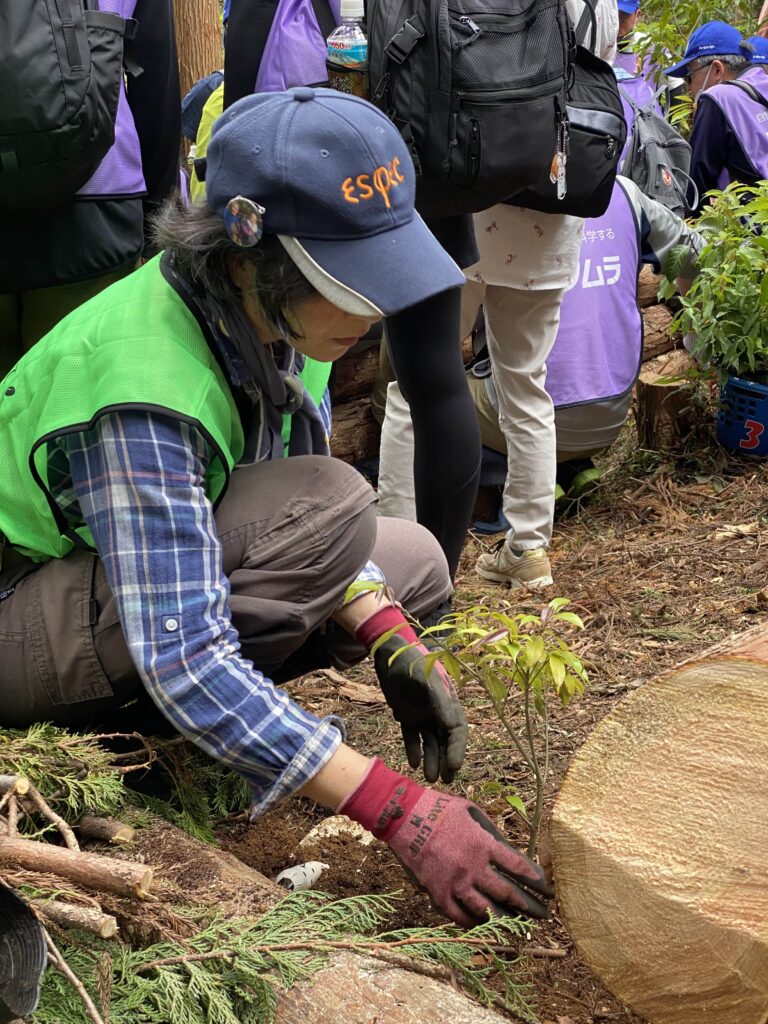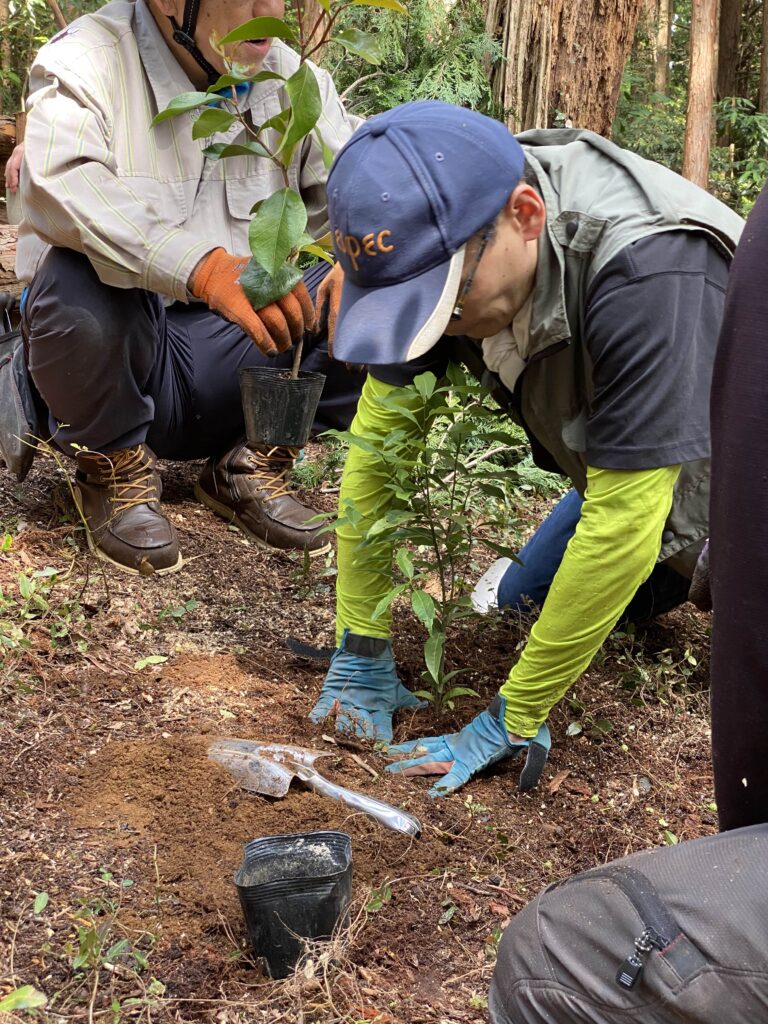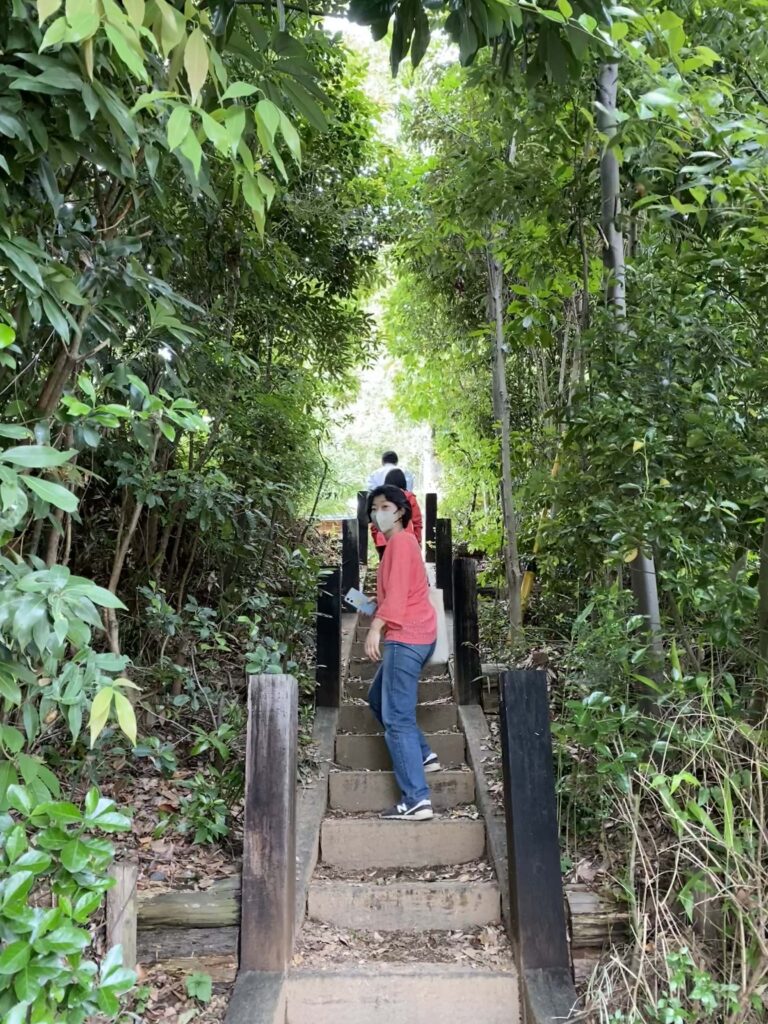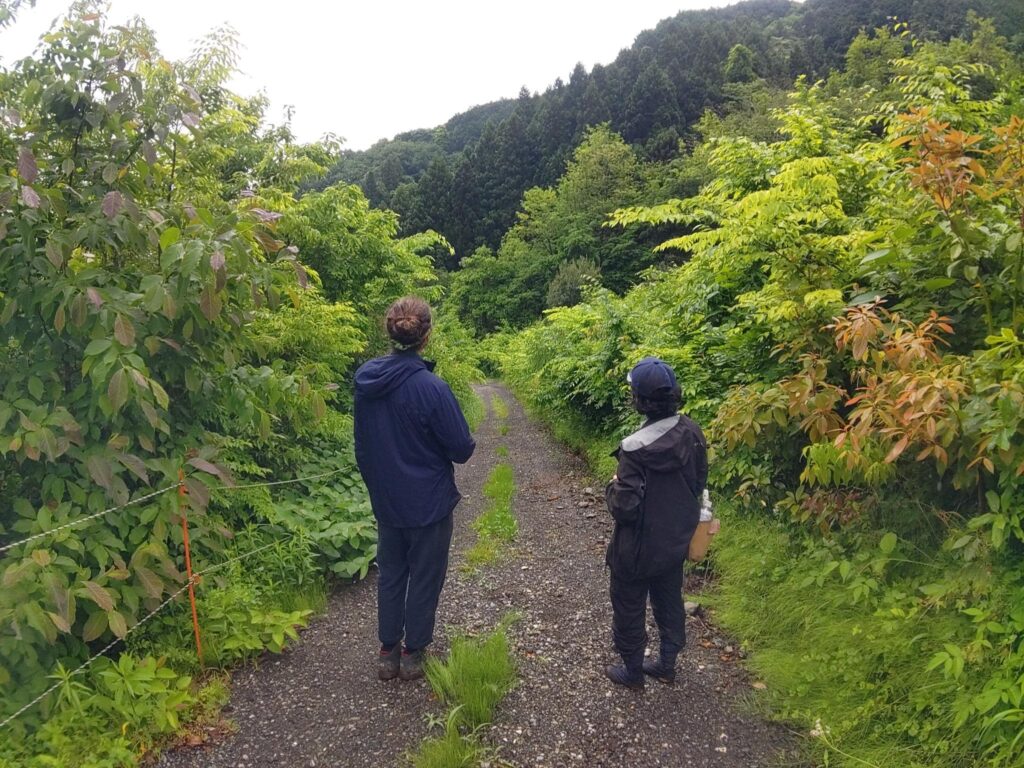Interview with Mio URATA, volunteer in Japan since 2004

In the spring of 2023, Damien and I traveled to Japan on a study tour to learn more about the Miyawaki method, and we were lucky enough to meet many passionate volunteers during our stay.
People who have been committed to planting Miyawaki forests for decades all over Japan, working closely with Professor Akira Miyawaki himself.
First trip to Japan: our grasp of the language was quite limited, and it’s not always easy to blend into this country where the community is based on many implicit codes. Yet we were warmly welcomed by all the volunteers we met. We were able to take advantage of several guided tours organized especially for us to see old and new Miyawaki forests, nurseries, or even to take part in forest planting events.
We really felt part of what appeared to us to be a big Japanese planting family, sharing warm moments on the planting grounds or in the izakaya for team parties organized after planting.
But all this would probably never have been possible without one remarkable person, namely Mio URATA.
Fluent in English, Mio was our very first point of contact with the Japanese planter community, helping us plan our trip to Japan and inviting us to all the events held there. She also took care of interpreting for us whenever we found ourselves in a Japanese-speaking group. Without her, this trip would not have been the same.
Beyond being a wonderful host, Mio is also a passionate volunteer who has been planting Miyawaki forests all over Japan for 20 years. She shared with us many fascinating details about the Miyawaki forests we visited and the people we met.
Her continuous involvement over all these years has led to her meeting many other enthusiasts like her, who share her learning about the Miyawaki method with as many people as possible.
Yet 20 years ago, Mio didn’t believe it was possible to grow a forest.
She told us this anecdote and many others during an interview we had with her: this article transcribes this inspiring and enthusiastic exchange.
Hello Mio ! Good to see you again ! Thank you for accepting to answer our questions for our followers. We first wanted to ask you how you came in touch with the Miyawaki method ?
I first knew about the Miyawaki method trough my partner, Anzai. He had listened to Dr. Miyawaki talk on the radio. The talk was about a new book that non fiction writer had written and it was all about Dr. Miyawaki’s life. He said on the radio that you could make a forest in 20 or 30 years.
Anzai believed that but I said « No! that’s impossible, you must have heard wrong !” I did not believe it at all.
Anzai started by reading Dr. Miyawaki’s book and got more into it. One day, he asked me to attend a weekend event that would be held in Yokohama. On Saturday. Dr. Miyawaki would give a lecture, there would be a symposium and on Sunday, a tree planting event.
It was a bit far away from home and I wanted to have a relaxing weekend, sleep in late, so I said that I did not want to go, at first. But Anzai-san can be very persuasive and he talked me in.
I have a full time job as a book editor, so I am very curious and my curiosity got the better of me. I went to the symposium and when I heard about Dr. Miyawaki and saw the presentation I was just amazed at what you can do and what he had done.
Dr. Miyawaki is a scientist, but one that does things. He had really changed the landscape, for example at Yokohama National University. He showed us the picture of when the trees were planted, and 3 years later, and 5 years later and then 23 years later. And I was like « Wow! this is true ! I am sorry, Anzai san that I didn’t believe you! ».
And I fell in love with Dr. Miyawaki too because he was so energetic. He was in his mid 70s but you could say he was in his 50s maybe.
Saturday ended that way, my life had changed, partly.
On Sunday, I went to the tree planting event. When I planted this little seedlings into the ground for the first time in my life, I knew that was what I really wanted to keep doing. It felt so alive and satisfying and fulfilling that I knew I had to continue doing this.
That was my encounter with the Miyawaki method, I was anti Miyawaki at first!
What made you make the decision of really committing into volunteer planting after this day? What kept you going?
Really good question! It started very gradually. I first met Dr. Miyawaki in 2004, and then, at that time, there wasn’t much information about him or tree planting events on the internet.
Anzai had to research a lot on the internet. In 2005, there was a forest maintenance event at the place that we planted on in 2004, so we went there and again, we were very inspired and motivated.
In 2006, we joined a group that were followers of Dr. Miyawaki, approved by himself. It was sort a special group that really followed Miyawaki-sensei’s teaching very thoroughly. We joined and that was the very beginning of our journey, the first step of getting more involved.
There were many tree planting events at that time. Miyawaki followers were all around Japan, in cities and municipalities, and Non-Profit Organizations would organise planting events.
We would travel all over Japan to participate in those tree planting events. We both like travelling and we could couple it with tree planting. Have fun and do something good for the environment. We made new friends, good friends, in that sense.
So 2006 was a really changing point for us and we got into it that way.

You mentioned this group of people who are followers of Dr. Miyawaki: do you know how they got involved in tree-planting projects? How did they come in contact with the Miyawaki method?
Yes, the group was originally formed by members of the Mitsubishi corporation.
This company held tree planting tours to Malaysia, Borneo, on the island. Members volunteers from Mitsubishi group would go down on those planting tours on Borneo. Some of them became really inspired by Dr. Miyawaki and also, they felt so good about planting trees in Borneo that they formed a small group.
Dr. Miyawaki was really happy about the group following him, so it stared like that. It’s Called « Mazerukai » in Japanese. « Mazeru » is a okayama dialect and it means « to mix ».
Dr. Miyawaki would always use this word, « mazeru mazeru mazeru! » That’s were the name comes from.
So, that’s this group that we joined, Mazerukai.
You said you got in touch with the Miyawaki method around 2004, which means you’ve been planting all over Japan for 20 years! You’ve taken part in a lot of planting events, but do you have a particular memory in mind, something that stood out for you at all these tree-planting events?
Just one? That’s difficult to answer!
One example I can give you is the tree planting on Mt Tsukuba. We worked on the mountain side and tilled the soil, and worked on it for weeks and weeks an weeks, maybe for the whole summer of 2007.
Every weekend I would go to Mount Tsukuba to prepare the planting site. It was really hard work!
I would use a pick axe to dig the soil and there were all these huge rocks on the mountain side so we would pick them up, cast them away, and continue for a long time, not just the summer, but maybe for 2 or 3 months.
That’s how we enlarged the planting site, bit by bit. Yeah, that was a very memorable event for me.
That sounds like exhausting work !
Also, you knew Dr. Miyawaki well and we wanted to ask you a question about him: for us, in France, he is a bit of an abstract person, could you tell us more about him, what kind of person he was ? Maybe more on the human side ?
He wasn’t very tall, just a little bit taller than me. Short and stout. But he emanated energy from all around.
I sometimes tell people that he was kind of like Yoda, in Star Wars. Yoda is more calm but Dr. Miyawaki was no always calm. He could be very energetic ! One word that describes him best is that he was charismatic.
I became in love with him in just one presentation and so many others were like that. Every time he would finish a presentation or a talk, there would be a long line of people waiting to talk to him in person or have his autograph. He was that popular.
He just changed people, he was someone.
Is there anything you feel has influenced you the most, on a personal level?
In his books, he says that if you are really truly determined to do something, it will go well, you could it. But if that something doesn’t go well, then you are not giving 100%.
He also said that in his lectures. That resonated with me for a long time.
And Dr. Miyawaki really was someone like that. He was always doing research or writing papers, books. He was called Mr. Seven when he was teaching at Yokohama National University because he would always arrive at the university at 7am sharp. That is just how he was, he would work from 7am to 11pm at night, maybe. He would also make his students do this as well.
You know what it means when you have to give 100%, that is the amount of energy you have to put into something if you really really want to make it happen.
More specifically on the Miyawaki method: the tree-planting actions we’ve carried out in France with Boomforest have mainly been motivated by the desire to combat the effects of climate change by restoring natural vegetated areas. Do you think the Miyawaki method is an interesting solution to cope with climate change?
Climate change is really happening and the Miyawaki method is a good way to combat climate change, because it rebuilds natural environment very quickly.
So for the first 3 year, the planting site and the trees might not look really tall, but here in Japan after 3 years, the trees go BOOM and become really really tall !
The trees and leaves create shade and the insects come back, and after the birds too. Biodiversity takes place there. And, restoring biodiversity is a very important aspect when facing climate change.
I love the way that when creating a Miyawaki forest we are creating a habitat for animals and that is a very fulfilling feeling.
Over the years, you trained many volunteers. What is the most important thing you share with them when they come to the tree planting?
To accept nature more, especially in the cities, not just in the countryside. That means to accept that trees, especially deciduous trees, shed leaves in fall and you have to cope with fallen leaves.
But that is not waste. Fallen leaves are actually organic mater that you can reuse. You should think of that as the large cycle of nature after you’ve planted trees.
Some of my friends, they don’t like insects and bugs, but you have to accept that insects are very important for the environment as well. Maybe people don’t like bugs or fallen leaves, or dense forests, but that is only from the human point of view.
From a much larger point of view you ave to accept those things because if you don’t human beings are doomed. If you kill all the bugs, then what are you gonna do?

In France, we have a tradition of managing nature, especially in the city, where plants must be tidy. For some reason, it’s ingrained in people’s minds that nature in the city must always be neat and tidy, and sometimes some people find it hard to accept that nature can look messy, cluttered, dense. The Miyawaki method is the exact opposite of this expectation. With so many species, everything becomes wild, the insects come back… As you mentioned, it’s a big challenge to change mentalities and get people to accept that nature works like this, and that it’s beneficial for our environment. But it takes a lot of time.
Absolutely. For example you saw the beautiful cherry blossom in Japan, but then – and I could not believe this – some people would say that they love the beautiful cherry blossom in spring but don’t like the fallen leaved in fall because they clog the draining system… so it’s like that in Japan too.
Regarding people organizing tree planting events in Japan: during our stay, we’ve participated in several tree plating events in many parts of Japan, Tokyo, Kyushu, Hokkaido… What do you think is motivating all these project leaders to start planting Miyawaki forests?
All these people were influenced by Dr. Miyawaki, his book, lecture, etc. He once had a TV series on national TV and many people were influenced by those media.
Dr. Miyawaki sadly passed away a couple years ago. Do you think there would be a new generation of project leaders that would start tree planting actions without the direct influence of Dr Miyawaki?
Difficult question. We have doubted about that here in Japan.
Maybe there will not be so many new people leading these kind of projects here in Japan now since Dr. Miyawaki passed away.
But now maybe it’s up to us, the people who were directly in touch with Dr. Miyawaki, to pass on the torch to the next generation, and that has become a very big task for us right now.
Many people are realising that we have to continue doing this or try to find some good ways to pass it on. Because, you know, in Japan, trends change very rapidly.
In bookstores for example, there a very popular author, he passes away, and after a couple years, that author’s books are off the shelf and replaced by new authors.
I think that is the kind of things that are happening right now with Dr. Miyawaki. He used to produce a lot of books an many people bought them and were influenced by them.
Sadly, those books have disappeared from the shelf now…
But you know, the Miyawaki method is such a superb way to restore the environment, that we can’t let it die.
Zooming out Japan, what do you think is missing today to make the Miyawaki Method more widely known and used around the world?
PR ? (laughs). To let more people know that Is one of the most efficient ways to save the planet. And it’s not just for the planet. It’s also for us, human beings to restore nature. It’s the only way human beings can survive.
Here in Japan, Dr. Miyawaki teamed up with Toyota and the company planted trees around their plants all over the world, so maybe teaming up with a global corporation could be one good solution ?

To conclude, a more personal question: as a volunteer for many years, do you have a message for French volunteers who are planting trees for the first time?
Yes! To the French volunteers that are taking part in France, I’d like everyone to continue volunteering!
It may seem slow at first, for the first 3 years you don’t really see the vibrant growth.
But after 3 years, the trees will really grow and give you a deep sense of satisfaction that you made something that will last into the future.
It’s not just for yourself, but for everyone. It’s not just for the humans but for all the living things, bugs included !
You are doing a good thing for every living creature on the Earth. It’s a deep sense of satisfaction, and it helps me from not being depressed ! It helps you to keep your spirits up, especially when there is so many bad news recently.
the Miyawaki method can be applied to every kind of land, whether it’s on the mountain side, coastline or within the city. Even with 1 square meter space, you can plant trees.
Every time you go to a new site, it gives you a new challenge.
You think : « how do we plant here ? How do we prepare the site ? How do we organise the people, get the seedlings, the mulch, how do we arrange everything ? Should this be this way or that way ? »
Thinking about all those things is really exciting for me. You have a chance to show your originality and experience. That’s one thing that I really like !
It’s never the same, they are all different. It’s the beauty of it. There are similarities sometimes, but it’s never the same. You always have to think a lot about it and give it everything you can.
You would have though that after 20 years of planting it could become repetitive but no, it’s always different.
Thank you for your time and answers, is there something you want to add?
Let’s keep on planting!
Interviewed by Boomforest on November 22nd, 2023.
